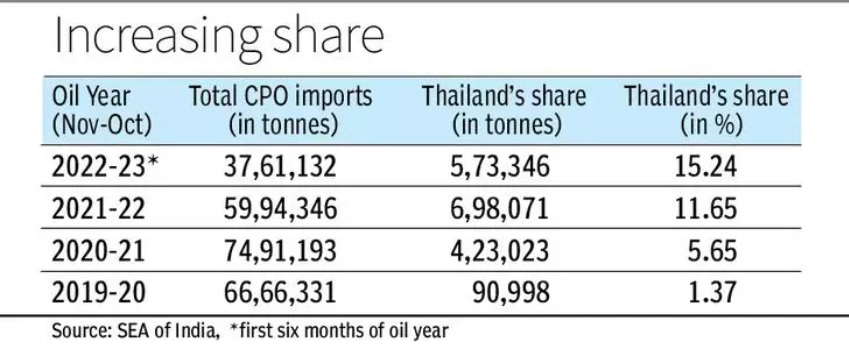New source market. Thailand comes to India’s rescue with crude palm oil exports

Shipments from Bangkok have increased over 15 per cent this season, from a meagre 1.37 per cent in 2019-20
In April 2022, Indonesia (one of the major palm oil producers in the world) announced a ban on the export of palm oil, which resulted in a shortage of edible oils in the global market. It also proved to be a turning point for Thailand, which till then was a minor supplier of crude palm oil (CPO) to India.
Thanks to the Indonesian ban, Thailand today has emerged as an important supplier of CPO to India. Another reason for India to increase imports is that Bangkok does not levy export duty on palm oil exports unlike Indonesia and Malaysia.
Though Indonesia and Malaysia remain major palm oil suppliers to India, Thailand’s share has risen to 11.65 per cent during the oil year 2021-22 (November to October), from 1.37 per cent in 2019-20 . Thailand’s share has increased to 15.24 per cent in the first six months of the oil year 2022-23.
USDA report
Data available with the Solvent Extractors’ Association (SEA) of India shows that Thailand’s palm oil exports were at 90,998 tonnes in 2019-20, which increased to 6.98 lakh tonnes (lt) in 2021-22. In fact, India imported 5.73 lt of palm oil in the first six months of the oil year 2022-23.

According to the June report of the United States Department of Agriculture (USDA) Foreign Agricultural Service titled ‘Oilseeds: World Markets and Trade’, Thailand produces around 3.5 million tonnes (mt) of palm oil.
The increase in Thailand-sourced palm oil started in 2021-22, a year when Malaysia and Indonesia faced challenges getting domestic production to export markets. The problems faced by the palm industry in these countries enabled Thailand to capture more than 10 per cent market share in India in 2021-22, the report said, adding this market share appears stable in 2022-23 given exports to date.
Rising production
Sudhakar Desai, President of the Indian Vegetable Oil Producers’ Association (IVPA), told businessline that Thailand had helped meet Indian demand when Indonesia had banned palm oil exports. Thailand has emerged a natural supplier of oil palm to India.
However, Thailand’s production does not match the scale of either Indonesia or Malaysia.
While palm oil production in Thailand would continue to grow, it would continue to be the third largest producer of oil palm. “I am told production is consistently increasing in that country,” he said, adding, it is good for India to de-risk from its dependence on Malaysia and Indonesia. Unlike Indonesia, Thailand is more interested in sending CPO to India, Desai said.
The USDA report said Thailand is now forecast as the third largest exporter of palm oil in 2022-23 with shipments forecast at 9,00,000 tonnes. It said exports from Thailand account for less than 2 per cent of the global palm oil trade.
Meagre output
Highlighting the logistical advantage of exporting from Thailand, BV Mehta, Executive Director of SEA of India, said a voyage from Phuket to any southern port in India is hardly 4-5 days, while it is around 10-12 days from Indonesia and Malaysia.
Though Thailand does not impose any export duty or levy on palm oil unlike Indonesia, its production is limited to around 3.5 mt. Of this, domestic consumption is around 1.3 mt, and around 1.2 mt is used for bio-diesel blending. With this, Thailand is left with around 1 mt for export.
Asked if there is scope for India to bargain for more palm oil from Thailand, Mehta said the country has limited quantities to sell. It is not a big producer, but has a surplus of a million tonnes. India has already bought it this year, he said.














